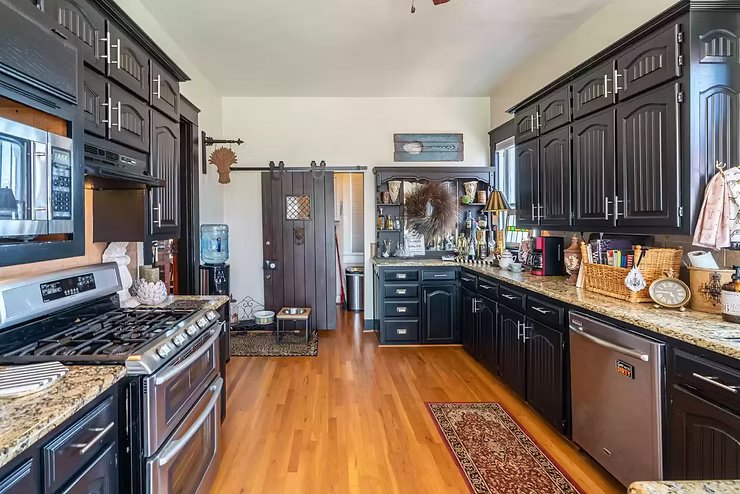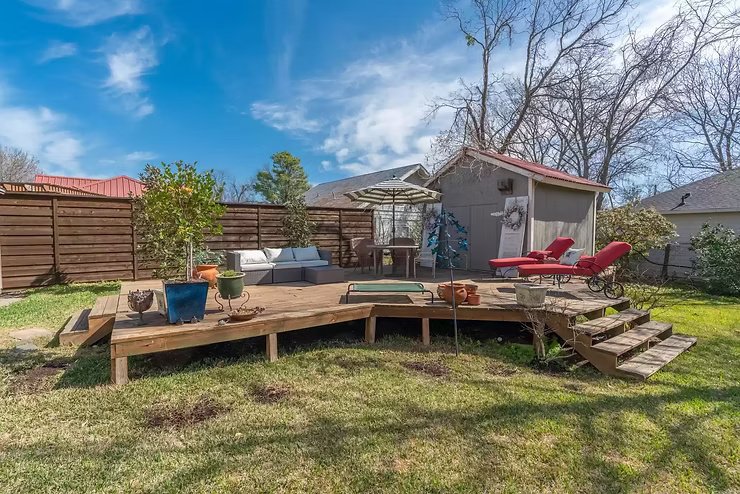There’s something deeply magnetic about homes that carry the grace of another era—places where history and craftsmanship meet modern comfort.
The Camp House, a 1914 Classical Revival residence recognized on the National Register of Historic Places, embodies this charm perfectly.
Standing proudly with its stately columns and grand symmetry, the home is a quintessential representation of early 20th-century Southern architecture, a time when design was guided by balance, refinement, and durability.
From the very first glance, the Camp House captivates with its dignified façade. Towering columns rise gracefully to support the two-story porch, evoking the elegance of Greek and Roman architecture that inspired the Classical Revival movement.
The symmetrical structure, framed by lush greenery, draws attention to the original front doors—beautifully preserved portals that open to a warm and inviting interior steeped in heritage.

Inside, the craftsmanship of the early 1900s shines through every detail. Gleaming hardwood floors flow seamlessly through the home, complemented by intricate trim and molding that highlight the artistry of its builders.
The coffered ceilings—carefully preserved—add a touch of sophistication to the main living spaces, while hand-poured windows, a rarity today, filter sunlight with a soft, timeless glow. Every corner whispers of an age when homes were built not just for shelter, but as enduring works of art.
While its historic elements have been lovingly maintained, the Camp House also embraces the needs of modern living. The updated kitchen stands as a perfect example of this thoughtful balance between old and new.
Equipped with a gas range, granite countertops, a dishwasher, and abundant storage, it provides a modern culinary experience without compromising the home’s historic character. The subtle blending of polished surfaces with original architectural textures creates a sense of continuity between past and present.
The front porch—a hallmark of Southern living—offers the perfect spot for gatherings or peaceful reflection. With its sweeping columns and welcoming atmosphere, it invites family and friends to sit back, unwind, and enjoy the rhythms of small-town Texas life.
Whether it’s an early morning coffee or an evening conversation under the soft glow of porch lights, this space encapsulates the heart of the home’s timeless appeal.

Upstairs, the Camp House continues to impress. The second floor features a large master bedroom with a spacious sitting area and double doors opening to a bright secondary living room. This additional living space includes a charming fireplace and French doors leading out to the balcony—ideal for enjoying the view or catching a gentle breeze.
Four additional bedrooms share a beautifully preserved bathroom complete with a clawfoot tub and shower, along with a separate water closet—a distinctive architectural feature that reflects the home’s early 20th-century design sensibilities.
The third floor, often a surprise to visitors, offers a flexible bonus room that adds even more charm and possibility to the residence. Whether envisioned as a guest bedroom, playroom, art studio, or music room, this quiet retreat provides a private escape within the grand home. The versatility of this upper level makes it easy to adapt the space to any family’s needs while maintaining its historical integrity.
Beyond its walls, the Camp House enjoys a prime location just steps from the heart of downtown. Its proximity to shops, restaurants, and live music venues ensures that the lively pulse of Texas community life is never far away. Yet despite being within walking distance of modern conveniences, the home retains a serene, timeless atmosphere—one that feels a world apart from the rush of contemporary life.
The Camp House is more than just a residence; it’s a living testament to a proud architectural tradition. Every feature, from its stately columns to its detailed interior finishes, tells the story of a bygone era while remaining perfectly suited for today’s lifestyle.
For admirers of Classical Revival architecture and lovers of history, this home represents an opportunity to experience a piece of Texas heritage in all its enduring beauty.
At over a century old, the Camp House continues to stand as a beacon of grace and craftsmanship—a place where history lives not in the past, but in every carefully preserved detail that still defines it today.
Camp House


































